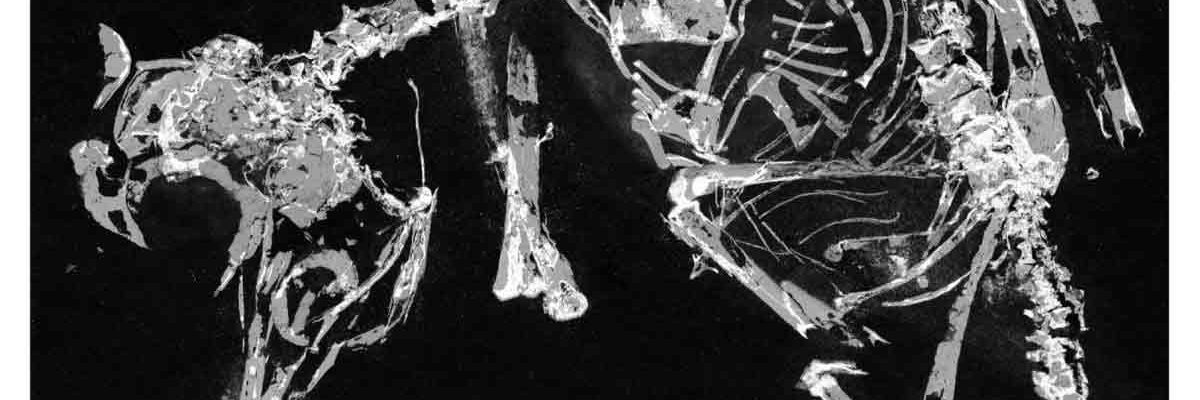Baby bird proves big deal to palaeontologists
Departments Dinosaurs Research impact and institutes 14th March 2018
A tiny bird that was smaller than your little finger and lived the briefest of lives has proven itself a giant of fossil history.
The chick in the picture below may look like a character from a Disney remake of Walking With Dinosaurs, but this little chap has provided us with a valuable insight into the evolution of birds. Most notably, it helps us understand better how birds evolved alongside the dinosaurs they shared the planet with during the Mesozoic Era.
Bird in the hand

The bird in question is thought to be an enantiornithean. These prehistoric creatures looked very similar to the birds that live today, but had claws on their wings and teeth in their beaks. So what does this new fossil discovery bring to the table?
Well, the bird in question lived a life that was cut abruptly short. While this is unquestionably bad news for the bird, it’s good news for lead author Dr Fabien Knoll and his team at The University of Manchester’s Interdisciplinary Centre for Ancient Life (ICAL) in the School of Earth and Environmental Sciences. The bird’s young age meant that its skeleton had yet to go through ossification and fuse, which makes it easier to examine the separate parts of its physiology.
“The evolutionary diversification of birds has resulted in a wide range of hatchling developmental strategies and important differences in their growth rates,” Dr Knoll explains. “By analysing bone development we can look at a whole host of evolutionary traits.” For example, the breastplate of the baby bird was still formed largely of cartilage, having yet to turn into hard bone. This told the researchers that the bird would not have been able to fly.
Flying the nest

While the little bird was no bigger than a grasshopper and couldn’t fly, that’s not to say it would have been entirely helpless. While some baby birds are totally reliant on their mother bird – remaining in the nest until they learn to fly and feeding on morsels brought back by their mum – others, like chickens, are fairly self-sufficient from birth, and are mobile as soon as they hatch.
Of particular interest to the scientists is just how similar the skeleton of the baby bird is to those alive today. The study’s co-author Luis Chiappe, of the LA Museum of Natural History, said: “This new discovery, together with others from around the world, allows us to peek into the world of ancient birds that lived during the age of dinosaurs. It is amazing to realise how many of the features we see among living birds had already been developed more than 100 million years ago.”
Early bird

The fossilised chick represents one of the earliest known birds. The general consensus is that birds evolved during the Mesozoic Era – the time that this little guy lived. The Mesozoic Era encompassed the Cretatious, Jurassic and Triassic periods, and is also known as the Age of Reptiles, as this was a time when dinosaurs ruled the planet.
While we’re more used to thinking of pterosaurs roaming the skies at this time, there were birds too. And, interestingly, birds are more closely related to dinosaurs than they are pterosaurs, which – unlike many dinosaurs – lacked feathers and were more likely to be furry, with wings formed from a skin membrane stretched between an elongated finger and the ankle.
Pterosaurs are often mistakenly referred to as dinosaurs but they were entirely different – they just shared the same planet. It would be a bit like saying humans are rodents. Birds, on the other hand, did start out as dinosaurs, with many scientists pointing to a type of theopoda dinosaur that moved on two legs and had hollow bones – just like birds today – as the forefather of modern birds.
Words – Hayley Cox
Images – The University of Manchester
dinosaurDinosaursEarth and Environmental Sciencesevolutionfossilpaleontology





mark nelson says
hi, at http://www.sofiamusicschool.nl ,foot of page is a foto of a related fossil ,not least because of a similar enanthior on side of stone ,with reverse folded back furry-barbule reverse wing on back of stone. main fossil is on first foto- a beaked ,toothed, 4 wing complete fossil ,bracchiopod on bottom right of shungite.